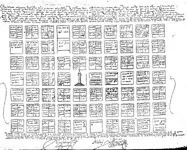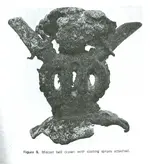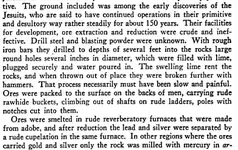Cactusjumper wrote
Roy,
I believe it's common knowledge that the Jesuit's worked iron and steel. They forged things needed in the missions.
Take care,
Joe
Joe - how much slag do you believe is produced by a forge?
That was a trick question; forging does not really produce slag. The operation of a forge is working iron and or steel that already exists, it is not actually melting the metal to the point of being liquid, which would then be hot enough to melt rock silica and other impurities as found in metal ores. Have you ever done any metal detecting of an old blacksmiths shop? I have done several, and it is interesting what you find - small bits of trimmed off waste iron, occasionally a heavily corroded tool or horseshoe, etc all things of iron and corroded iron, plenty of ash, but never slag.
Slag by definition is the by product of metal smelting, not forging, or sometimes volcanoes produce slag which is actually quite different in makeup from that produced by a smelter; which only makes sense as the smelter is deliberately melting specific types of rock with metal content while the volcano can't be choosy. Smelting operations are done at a higher temperature than a forge operates; a forge CAN get hot enough to melt metal to a liquid state but that would be a disaster for the blacksmith as he only wants to soften it to make it easier to work, not turn it into a liquid that could splash, spill etc. Slag is made up of rock silica and the impurities that float on top of the metal in the smelting process, not really possible to produce it by working iron in a forge as you simply don't have waste rock in the process even if you were working at the extreme temperatures of a smelter rather than the very high temperatures of a forge. No blacksmith would allow sizable quantities of rock to be in with his metal that he is working on to produce slag for that matter.
We have been over this point before if memory serves and clearly you do not believe me when I say it. Here is the dictionary definition of slag:
- 1. stony waste matter separated from metals during the smelting or refining of ore. <Google>
- 1. Stony waste matter separated from metals during the smelting or refining of ore.
2. Similar material produced by a volcano; scoria. <Oxford Dictionary>
- 1. The vitreous mass left as a residue by the smelting of metallic ore. 2. See scoria. <FreeDictionary.com>
Perhaps if you would contact a blacksmith and ask him (or her) how much slag is produced by using his forge, it might help settle this issue for you?
Even if a forge were producing slag at all, perhaps by the hot metal accidentally coming into contact with dirt or ash etc, the amount thus produced would be very small, certainly not enough to fill wagons as was found at the missions. The stuff found at the missions did not come from operating forges.
<photo of slag>
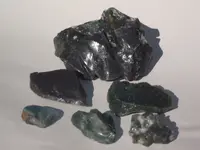
Perhaps what you mean to say is not "forging" irons and steels at the missions to make tools, but primitive foundry work? They are called "Bloomery" type foundries, a fairly good explanation on Wiki:
Bloomery - Wikipedia, the free encyclopedia
Picture of an iron Bloomery foundry
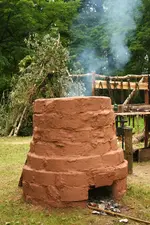
If we try to explain the piles of slag found at the missions as the result of iron foundries (Bloomeries) then we are left with another problem in explaining where they obtained the iron ORE to be smelting in a foundry? As far as I know, not a single example of an iron mine has ever been found in Arizona that was worked prior to the arrival of the Americans. On the other hand, we have a whole string of old mines discovered by the first Americans to arrive, which they were informed by the local Indians had been worked by the padres, and these mines are not iron mines but mostly silver, and a few gold. Father Nentvig listed several mines as being associated with the missions, and not in the separate chapter for the Spanish owned and operated mines, which seem to coincide with the same mines the Indians told the first Americans had been worked by the padres. I think it is kind of reaching to try to explain these "coincidences" away but that is just an opinion. Nentvig makes no mention of any iron mine(s) in Pimeria Alta, nor for that matter of any iron foundry producing iron or steel in Pimeria. Pfefferkorn makes no mention of any iron foundries in Sonora. It is possible that there were iron foundries (of the primitive bloomery type) yet there is no mention of them, and rather we find that the missions were importing iron tools and not producing them locally.
I hope all is well with you folks,
Roy





